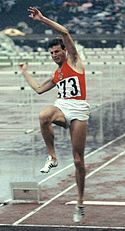Mistrzostwa Europy w Lekkoatletyce 1962 – skok w dal mężczyzn
| |||
Skok w dal mężczyzn był jedną z konkurencji rozgrywanych podczas VII Mistrzostw Europy w Belgradzie. Kwalifikacje rozegrano 13 września, a finał 14 września 1962. Zwycięzcą tej konkurencji został reprezentant ZSRR, mistrz z 1958 Igor Ter-Owanesian. W rywalizacji wzięło udział dwudziestu zawodników z trzynastu reprezentacji.
Rekordy
| Rekord świata | 8,31 | Erywań, ZSRR | 10.06.1962[1] | |
| Rekord Europy | 8,31 | Erywań, ZSRR | 10.06.1962 | |
| Rekord mistrzostw | 7,81 | Sztokholm, Szwecja | 20.08.1958 |
Wyniki
Kwalifikacje
| Miejsce | Zawodnik | Wynik | Uwagi |
|---|---|---|---|
| 1 | 7,82 | Q CR | |
| 2 | 7,67 | Q | |
| 3 | 7,65 | Q | |
| 4 | 7,62 | Q | |
| 5 | 7,57 | Q | |
| 6 | 7,51 | Q | |
| 7 | 7,49 | Q | |
| 8 | 7,45 | Q | |
| 9 | 7,45 | Q | |
| 10 | 7,41 | Q | |
| 11 | 7,37 | Q | |
| 12 | 7,37 | Q | |
| 13 | 7,36 | ||
| 14 | 7,32 | ||
| 15 | 7,27 | ||
| 16 | 7,23 | ||
| 17 | 7,12 | ||
| 18 | 7,09 | ||
| 19 | 7,06 | ||
| 20 | 7,01 |
Finał
| Miejsce | Zawodnik | Wynik | Uwagi |
|---|---|---|---|
| 1 | 8,19 | Wiatr +3,2 | |
| 2 | 7,85 | ||
| 3 | 7,85 | ||
| 4 | 7,83 | ||
| 5 | 7,73 | ||
| 6 | 7,66 | ||
| 7 | 7,52 | ||
| 8 | 7,41 | ||
| 9 | 7,40 | ||
| 10 | 7,33 | ||
| 11 | 7,33 | ||
| 12 | 6,78 |
Przypisy
- ↑ Progression of IAAF World Records. 2015 Edition (ang.). IAAF. s. 174. [dostęp 2018-10-18].
Bibliografia
- Berlin 2018 Statistics Handbook (ang.). European Athletics. s. 518. [dostęp 2018-10-19].
- European Athletics Championships – Beograd 1962 (ang.). European Athletics. [dostęp 2018-10-19].
| ||||
Media użyte na tej stronie
Pictograms of Olympic sports – . This is an unofficial sample picture. Images of official Olympic pictograms for 1948 Summer Olympics and all Summer Olympics since 1964 can be found in corresponding Official Reports.
An icon that represents a gold medal
An icon that represents a silver medal
Flaga Finlandii
An icon that represents a bronze medal
Autor: Scroch, Licencja: CC BY-SA 4.0
National Flag of the People's Republic of Bulgaria (1948-1967). Tha flag has got the coat-of-arms from 1948
Flag of Romania (24 September 1952 - 21 August 1965)
Construction sheet of the Flag of Romania as depicted in Decree nr. 972 from 5 November 1968.
- l = 2/3 × L
- C = 1/3 × L
- S = 2/5 × l
Autor: SanchoPanzaXXI, Licencja: CC BY-SA 4.0
Flag of Spain during the Spanish State. It was adopted on 11 October 1945 with Reglamento de Banderas Insignias y Distintivos (Flags, Ensigns and Coats of Arms Bill)
Flag of Portugal, created by Columbano Bordalo Pinheiro (1857-1929), officially adopted by Portuguese government in June 30th 1911 (in use since about November 1910). Color shades matching the RGB values officially reccomended here. (PMS values should be used for direct ink or textile; CMYK for 4-color offset printing on paper; this is an image for screen display, RGB should be used.)
Flag of the Socialist Federal Republic of Yugoslavia (1946-1992).
The design (blazon) is defined in Article 4 of the Constitution for the Republic of Yugoslavia (1946). [1]
Flag of the Socialist Federal Republic of Yugoslavia (1946-1992).
The design (blazon) is defined in Article 4 of the Constitution for the Republic of Yugoslavia (1946). [1]
Flag of Romania (24 September 1952 - 21 August 1965)
Construction sheet of the Flag of Romania as depicted in Decree nr. 972 from 5 November 1968.
- l = 2/3 × L
- C = 1/3 × L
- S = 2/5 × l
Igor Ter-Ovanesyan, 1964 Olympics
















